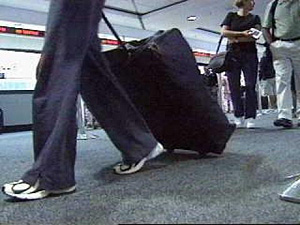 |
 |
 |
 Travel & Outdoors | May 2007 Travel & Outdoors | May 2007  
Foreign Tourists Avoid US, but Industry has Strong Internal Market
 Agence France Presse Agence France Presse


| | Foreign tourists are increasingly avoiding visits to the United States, but the US tourism industry remains strong thanks to a healthy internal market, according to industry officials. |
The US tourism industry officials said they had a record year in 2006, reporting profits of some 1.2 billion dollars, according to figures released Wednesday.

This despite the number of foreign visitors to the United States, not including Canada and Mexico, dropping from 26 million in 2000 to 21.7 million in 2006.

"We are very close to the level prior 9-11," said an optimistic US Deputy Commerce Secretary David Sampson on Wednesday, referring to the September 11, 2001 terror attacks in the United States.

"We are hopeful we'll reach the number of visitors prior 9/11 in a very near future," he said.

The health of the US tourism industry is explained by the strong internal market buoyed by visits from Canadians and Mexicans, said Roger Dow, president of the Travel Industry Association (TIA), a trade industry group.

"Those numbers are very encouraging but they mask another challenge," said Dow.

"Domestic travel is extraordinary strong and international travellers is above 51 million. But if you pull the numbers apart: Canada and Mexico make up 29 million of those 51 million travelers," he said.

The number of Canadian visitors was up 10 percent up from 2000, with the number of Mexican visitors up 26 percent. Historically however most Canadian and Mexican visitors stay within a limited area near their respective borders.

However the number of tourists from other nations dropped 17 percent between 2000 and 2006, from 26 million to 21.7 million. Not even the euro's strength against the dollar has encouraged Europeans to visit the United States, Dow said.

Compared to 2000, the number of German visitors is down 22 percent to 1.4 million, and French visitors are down 28 percent to 790,000. In that same period the number of British tourists dropped 11 percent to 4.2 million, and the number of Japanese visitors dropped 27 percent to 3.7 million.

"We have a bargain dollar. With the dollar where it is now, we should have 60 millions visitors or so," Dow said.

In 1992 the United States represented nine percent of the global tourism market. This dropped to six percent in 2006, he said.

Trade officials blame strict visa requirements and security restrictions for discouraging more tourists from visiting.

"The industry cares more than anyone about security," said Dow. "But we have to improve the entry process. We are not saying to get soft about security, but get smart about it."

He cites Brazil as an example, where it takes at least two months to get a tourist visa to the United States. The result: while one million Brazilians visited the United States in 1998, a mere 525,000 came in 2006 - and some two million Brazilians visited other foreign destinations, including Europe and Asia.

According to a survey by the Discover America Partnership group, 70 percent of foreign tourists fear US immigration officials, and 66 percent fear they will be detained at a US airport for security reasons by mistake.

The TIA is lobbying Congress to exempt many countries from tourist visa requirements.

Currently visitors from 27 countries - including France, South Korea, and Poland - need no tourist visa to come to the United States. | 
 | |
 |



